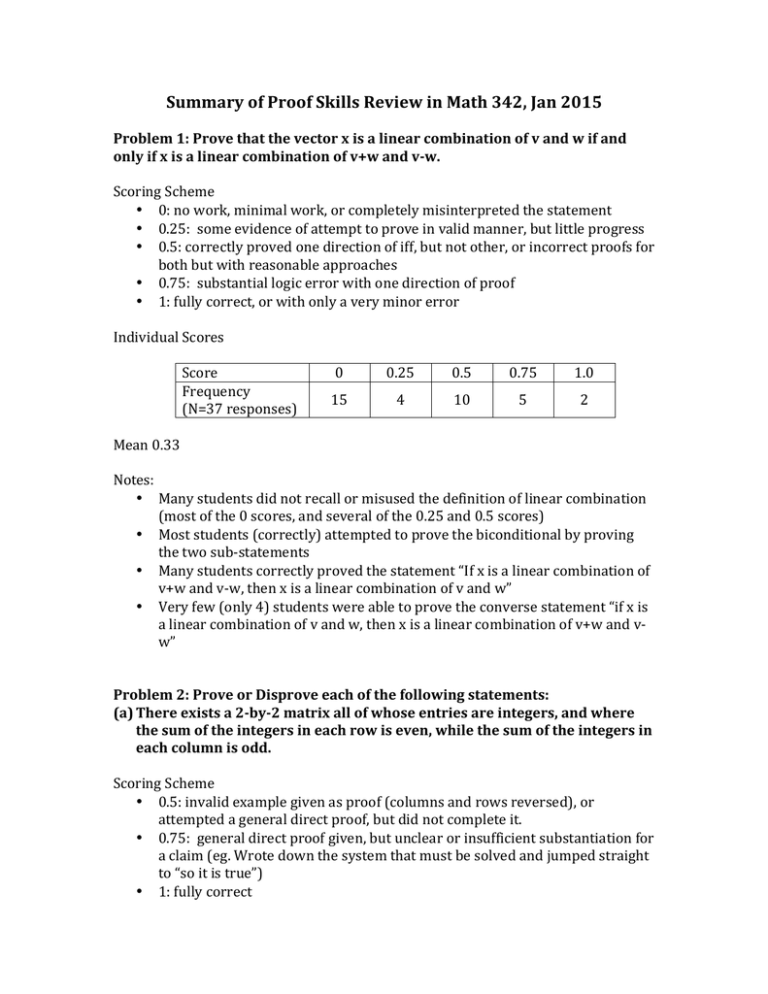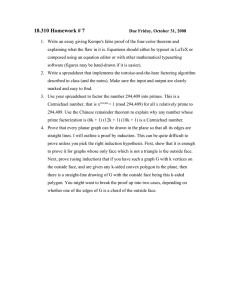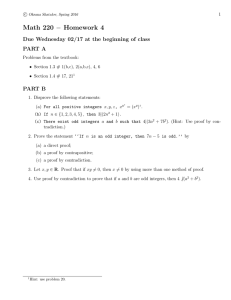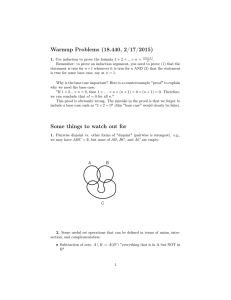Document 11108795
advertisement

Summary of Proof Skills Review in Math 342, Jan 2015 Problem 1: Prove that the vector x is a linear combination of v and w if and only if x is a linear combination of v+w and v-­‐w. Scoring Scheme • 0: no work, minimal work, or completely misinterpreted the statement • 0.25: some evidence of attempt to prove in valid manner, but little progress • 0.5: correctly proved one direction of iff, but not other, or incorrect proofs for both but with reasonable approaches • 0.75: substantial logic error with one direction of proof • 1: fully correct, or with only a very minor error Individual Scores Score 0 0.25 0.5 0.75 1.0 Frequency 15 4 10 5 2 (N=37 responses) Mean 0.33 Notes: • Many students did not recall or misused the definition of linear combination (most of the 0 scores, and several of the 0.25 and 0.5 scores) • Most students (correctly) attempted to prove the biconditional by proving the two sub-­‐statements • Many students correctly proved the statement “If x is a linear combination of v+w and v-­‐w, then x is a linear combination of v and w” • Very few (only 4) students were able to prove the converse statement “if x is a linear combination of v and w, then x is a linear combination of v+w and v-­‐ w” Problem 2: Prove or Disprove each of the following statements: (a) There exists a 2-­‐by-­‐2 matrix all of whose entries are integers, and where the sum of the integers in each row is even, while the sum of the integers in each column is odd. Scoring Scheme • 0.5: invalid example given as proof (columns and rows reversed), or attempted a general direct proof, but did not complete it. • 0.75: general direct proof given, but unclear or insufficient substantiation for a claim (eg. Wrote down the system that must be solved and jumped straight to “so it is true”) • 1: fully correct Individual Scores Score 0 0.25 0.5 0.75 1.0 Frequency 0 0 4 2 30 (N=36 responses) Mean 0.93 Notes: • Most students provided a proof by constructing an example, often after first deriving the system of equations that must be satisfied and then choosing a particular solution. • Many students (8) produced a general direct proof (derived the system of equations and proved that it had at least one solution) (b) There exists a 3-­‐by-­‐3 matrix all of whose entries are integers, and where the sum of the integers in each row is even, while the sum of the integers in each column is odd. Scoring Scheme • 0: nearly blank, claimed true and gave invalid example, or claimed true and gave an incorrect or incomplete proof. • 0.25: derived the equations that must be satisfied, but did not successfully prove or make a statement indicating it was false. • 0.5: correctly indicated it was false, but either did not try to prove or had major errors or incompleteness in the proof given. • 0.75: correctly indicated it was false, but had minor error, lack of clarity or insufficient justification in proof given. • 1: fully correct Individual Scores Score 0 0.25 0.5 0.75 1.0 Frequency 7 5 10 11 3 (N=36 responses) Mean 0.49 Notes: • Most (24) students correctly found the statement to be false • Many (7) students tried a proof by cases, but then failed to address all possible cases (eg. For a row to be even, it must have 0 or 2 odd integers in it. Then considered only the cases where all rows had 0 odd integers, or all rows had 2 odd integers). • • • Several (5) students tried to write a proof by contradiction, but could not arrive at a contradiction. Many (8) students derived a system of equations that must be satisfied, but didn’t know what to do from there Several students made unsubstantiated claims/simplifying assumptions (eg. All rows sum to the same value, 2n). Problem 3: Let m be an integer greater or equal to 3. Prove that for every integer n>0, m-­‐1 is a divisor of m^n-­‐1. Scoring Scheme • 0: blank, or just tried a few values of n and m. Minimal attempt at a direct proof (just a bit of unproductive algebra) • 0.25: indication induction would be used, showed only the base case, no indication of inductive step trying to be proved. • 0.5: attempted induction, either variable, with correct base case but did not prove inductive step. Direct proof only for fixed value m=3. • 0.75: correct proof (direct or induction), but with minor error • 1: fully correct (direct or induction) Individual Scores Score 0 0.25 0.5 0.75 1.0 Frequency 11 4 12 2 6 (N=35 responses) Mean 0.41 Notes: • Many (14) students attempted induction, most made some errors. • (9) used n as the induction variable, (2) used m as the induction variable, (3) used some combination of m and n as the induction variables (eg m for base case, n for inductive step, or attempted induction simultaneously in both variables). • Many (7) constructed a direct proof by the binomial theorem. Two of these first broke it into cases (n even, n odd). • Most students seem to be familiar with induction, but there were signs that many of them know it just as a procedure and don’t really understand what the goal of the inductive step is. Problem 4: Let x be an integer. Prove that if x^2 is divisible by 4, then x is odd. There were only 9 responses to this optional problem. Notes: • 2 students constructed a correct proof by contrapositive. • 2 students constructed a correct proof by contrapositive, but drew no relationship between his or her proof and the original statement. • 3 students constructed a correct, but less efficient, proof by cases (x is even, x is odd) • 2 students attempted direct proofs, but made an unjustified logical leap or claim



